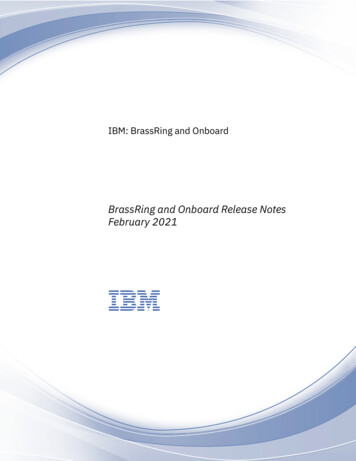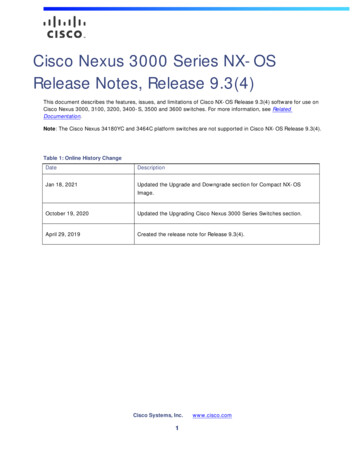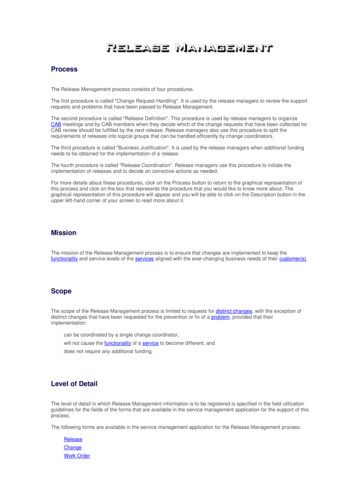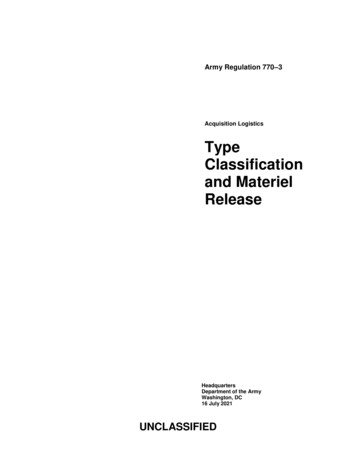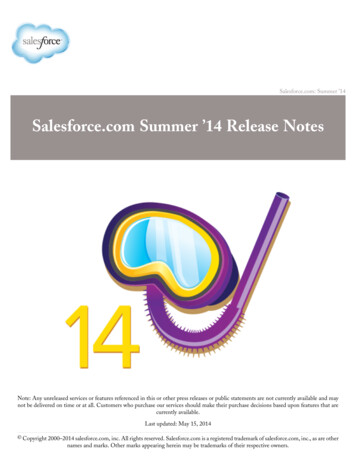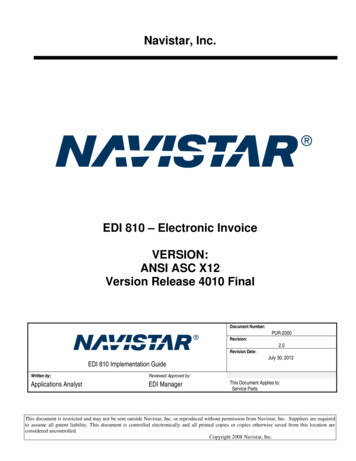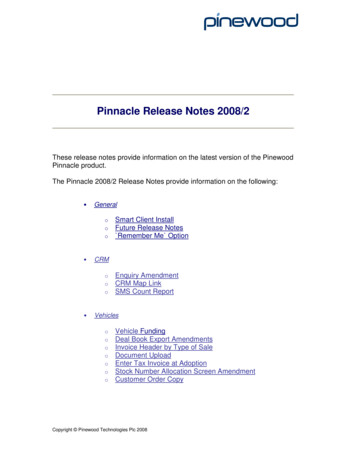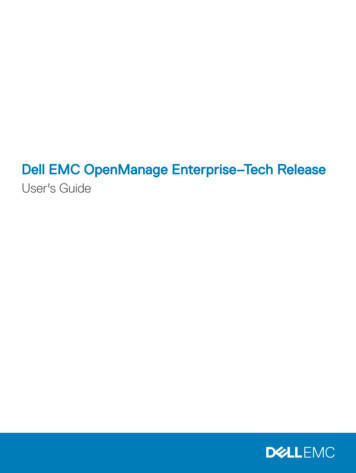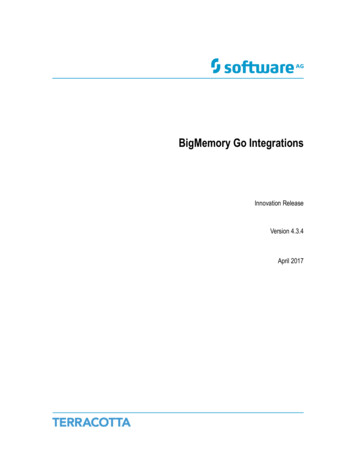
Transcription
BigMemory Go IntegrationsInnovation ReleaseVersion 4.3.4April 2017
This document applies to BigMemory Go Version 4.3.4 and to all subsequent releases.Specifications contained herein are subject to change and these changes will be reported in subsequent release notes or new editions.Copyright 2010-2017 Software AG, Darmstadt, Germany and/or Software AG USA Inc., Reston, VA, USA, and/or its subsidiaries and/orits affiliates and/or their licensors.The name Software AG and all Software AG product names are either trademarks or registered trademarks of Software AG and/orSoftware AG USA Inc. and/or its subsidiaries and/or its affiliates and/or their licensors. Other company and product names mentionedherein may be trademarks of their respective owners.Detailed information on trademarks and patents owned by Software AG and/or its subsidiaries is located ath p://softwareag.com/licenses.Use of this software is subject to adherence to Software AG's licensing conditions and terms. These terms are part of the productdocumentation, located at h p://softwareag.com/licenses and/or in the root installation directory of the licensed product(s).This software may include portions of third-party products. For third-party copyright notices, license terms, additional rights orrestrictions, please refer to "License Texts, Copyright Notices and Disclaimers of Third Party Products". For certain specific third-partylicense restrictions, please refer to section E of the Legal Notices available under "License Terms and Conditions for Use of Software AGProducts / Copyright and Trademark Notices of Software AG Products". These documents are part of the product documentation, locatedat h p://softwareag.com/licenses and/or in the root installation directory of the licensed product(s).Use, reproduction, transfer, publication or disclosure is prohibited except as specifically provided for in your License Agreement withSoftware AG.Document ID: BMG-INT-434-20170419
MTable of ContentsTable of ContentsUsing BigMemory Go with Hibernate. 5About Using BigMemory Go with Hibernate. 6Downloading and Installing BigMemory Go for Hibernate. 6Building with Maven. 6Configuring BigMemory Go as the Second-Level Cache Provider. 7Enabling Second-Level Cache and Query Cache Settings.8Configuring Hibernate Entities to use Second-Level Caching.9Configuring ehcache.xml Settings. 10Ehcache Settings for Domain Objects. 10Ehcache Settings for Collections. 10Ehcache Settings for Queries. 11The Demo Application and Tutorial.12Performance Tips.13Viewing Hibernate Statistics. 13FAQ. 13Using BigMemory Go with ColdFusion.15About ColdFusion and BigMemory Go.16Example Integration.16Using BigMemory Go with Spring. 17Using Spring 3.1.18Spring 2.5 to 3.1.18Annotations for Spring Project.19Using BigMemory Go with JSR107.21About BigMemory Go Support for JSR107. 22BigMemory Go Integrations Version 4.3.4 (Innovation Release)3
MEven HeaderBigMemory Go Integrations Version 4.3.4 (Innovation Release)4
MOdd HeaderUsing BigMemory Go with Hibernate1Using BigMemory Go with Hibernate About Using BigMemory Go with Hibernate .6 Downloading and Installing BigMemory Go for Hibernate .6 Building with Maven .6 Configuring BigMemory Go as the Second-Level Cache Provider .7 Enabling Second-Level Cache and Query Cache Settings .8 Configuring Hibernate Entities to use Second-Level Caching .9 Configuring ehcache.xml Settings .10 The Demo Application and Tutorial .12 Performance Tips .13 Viewing Hibernate Statistics .13 FAQ .13BigMemory Go Integrations Version 4.3.4 (Innovation Release)5
MEven HeaderUsing BigMemory Go with HibernateAbout Using BigMemory Go with HibernateBigMemory Go easily integrates with the Hibernate Object/Relational persistence andquery service. To configure BigMemory Go for Hibernate:Download and install BigMemory Go in your project as described in “Downloadingand Installing BigMemory Go for Hibernate” on page 6.Configure BigMemory Go as a cache provider in your project's Hibernateconfiguration as described in “Configuring BigMemory Go as the Second-LevelCache Provider” on page 7.Enable second-level caching in your project's Hibernate configuration as described in“Enabling Second-Level Cache and Query Cache Se ings” on page 8.Configure Hibernate caching for each entity, collection, or query that you want tocache as described in “Configuring Hibernate Entities to use Second-Level Caching”on page 9.Configure the ehcache.xml file for each entity, collection, or query configured forcaching as described in “Configuring ehcache.xml Se ings” on page 10.For additional information about cache configuration in Hibernate, see the Hibernateproduct documentation at “h p://www.hibernate.org/”.Downloading and Installing BigMemory Go for HibernateThe Hibernate provider is in the ehcache-ee module provided in the BigMemory Go kit.Building with MavenDependency versions vary with the specific kit you intend to use. Each kit is guaranteedto contain compatible artifacts, so find the artifact versions you need by downloading akit. Configure or add the following repository to your build (pom.xml): repository id terracotta-releases /id url ses /url releases enabled true /enabled /releases snapshots enabled false /enabled /snapshots /repository Configure or add the defined by the following dependency to your build (pom.xml): dependency groupId net.sf.ehcache /groupId artifactId ehcache-ee /artifactId version {ehcacheVersion} /version /dependency dependency BigMemory Go Integrations Version 4.3.4 (Innovation Release)6
MOdd HeaderUsing BigMemory Go with Hibernate groupId org.terracotta.bigmemory /groupId artifactId bigmemory /artifactId version {bigmemoryVersion} /version /dependency For the Hibernate-Ehcache integration, add the following dependency: dependency groupId org.hibernate /groupId artifactId hibernate-ehcache /artifactId version {hibernateVersion} /version /dependency For example, the Hibernate-Ehcache integration dependency for Hibernate 4.0.0 is: dependency groupId org.hibernate /groupId artifactId hibernate-ehcache /artifactId version 4.0.0 /version /dependency Note:Some versions of hibernate-ehcache might have a dependency on a specificversion of Ehcache. Check the hibernate-ehcache POM.Configuring BigMemory Go as the Second-Level CacheProviderTo configure BigMemory Go as a Hibernate second-level cache, set the region factoryproperty to one of the following in the Hibernate configuration. The Hibernateconfiguration is specified either by hibernate.cfg.xml, hibernate.properties or Spring. Theformat shown below is for hibernate.cfg.xml.Hibernate 3.3 (and later 3.x versions)For instance creation, use: property name "hibernate.cache.region.factory class" net.sf.ehcache.hibernate.EhCacheRegionFactory /property To force Hibernate to use a singleton of Ehcache CacheManager, use: property name "hibernate.cache.region.factory class" tory /property Hibernate 4.xFor Hibernate 4, use stead of net.sf.ehcache.hibernate.EhCacheRegionFactory, onFactory instead actory.BigMemory Go Integrations Version 4.3.4 (Innovation Release)7
MEven HeaderUsing BigMemory Go with HibernateEnabling Second-Level Cache and Query Cache SettingsIn addition to configuring the second-level cache provider se ing, you will need to turnon the second-level cache (by default it is configured to off - 'false' - by Hibernate). To dothis, set the following property in your Hibernate config: property name "hibernate.cache.use second level cache" true /property You might also want to turn on the Hibernate query cache. To do this, set the followingproperty in your Hibernate config: property name "hibernate.cache.use query cache" true /property Setting the ConfigurationResourceName PropertyYou can optionally set the ConfigurationResourceName property to specify thelocation of the Ehcache configuration file to use with the given Hibernate instance andcache provider/region-factory. The resource is searched for in the root of the classpath.It is used to support multiple CacheManagers in the same VM. It tells Hibernate whichconfiguration to use. An example might be "ehcache-2.xml."When using multiple Hibernate instances, it is recommended to use multiple nonsingleton providers or region factories, each with a dedicated Ehcache nResourceName /name of ehcache .xmlSetting the Hibernate Cache Provider ProgrammaticallyYou can optionally specify the provider programmatically in Hibernate by addingnecessary Hibernate property se ings to the configuration before creating nate.cache.region.factory ory")For Hibernate 4, use org.hibernate.cache.ehcache.EhCacheRegionFactory insteadof ing it all TogetherIf you are enabling both second-level caching and query caching, then your Hibernateconfig file should contain the following: property name "hibernate.cache.use second level cache" true /property property name "hibernate.cache.use query cache" true /property property name "hibernate.cache.region.factory class" net.sf.ehcache.hibernate.EhCacheRegionFactory /property An equivalent Spring configuration file would contain: prop key "hibernate.cache.use second level cache" true /prop prop key "hibernate.cache.use query cache" true /prop prop key "hibernate.cache.region.factory class" net.sf.ehcache.hibernate.EhCacheRegionFactory /prop BigMemory Go Integrations Version 4.3.4 (Innovation Release)8
MOdd HeaderUsing BigMemory Go with HibernateFor Hibernate 4, use org.hibernate.cache.ehcache.EhCacheRegionFactory insteadof net.sf.ehcache.hibernate.EhCacheRegionFactory in both samples given above.Configuring Hibernate Entities to use Second-Level CachingIn addition to configuring the Hibernate second-level cache provider,Hibernate must also be configured to enable caching for entities, collections,and queries. For example, to enable cache entries for the domain objectcom.somecompany.someproject.domain.Country, there would be a mapping file similarto the following: hibernate-mapping classname "com.somecompany.someproject.domain.Country"table "ut Countries"dynamic-update "false"dynamic-insert "false" . /class /hibernate-mapping To enable caching for this domain object, you add the following element to its mappingentry: cache usage "read-write nonstrict-read-write read-only" / For example: hibernate-mapping classname "com.somecompany.someproject.domain.Country"table "ut Countries"dynamic-update "false"dynamic-insert "false" cache usage "read-write" / . /class /hibernate-mapping You can also enable caching using the @Cache annotation as shown below.@Entity@Cache(usage CacheConcurrencyStrategy.READ WRITE)public class Country {.}Definition of the Different Cache Strategiesread-only - Caches data that is never updated.nonstrict-read-write - Caches data that is sometimes updated without everlocking the cache. If concurrent access to an item is possible, this concurrencystrategy makes no guarantee that the item returned from the cache is the latestversion available in the database. Configure your cache timeout accordingly.BigMemory Go Integrations Version 4.3.4 (Innovation Release)9
MEven HeaderUsing BigMemory Go with Hibernateread-write - Caches data that is sometimes updated while maintaining thesemantics of "read commi ed" isolation level. If the database is set to "repeatableread," this concurrency strategy almost maintains the semantics. Repeatable-readisolation is compromised in the case of concurrent writes.Configuring ehcache.xml SettingsBecause the ehcache.xml file has a defaultCache, caches will always be created whenrequired by Hibernate. However you can gain more control over Hibernate cachesby configuring each cache based on its name. Doing this is particularly important,because Hibernate caches are populated from databases, and there is potential forthem to become very large. You can control the size of a Hibernate cache by capping itsmaxEntriesLocalHeap property and specifying whether to swap to disk beyond that.Ehcache Settings for Domain ObjectsHibernate bases the names of Domain Object caches on the fullyqualified name of Domain Objects. So, for example, a cache forcom.somecompany.someproject.domain.Country would be represented by a cacheconfiguration entry in ehcache.xml similar to the following: ?xml version "1.0" encoding "UTF-8"? ehcache cachename riesLocalHeap "10000"eternal "false"timeToIdleSeconds "300"timeToLiveSeconds "600" persistence strategy "localTempSwap"/ / /ehcache Hibernate CacheConcurrencyStrategy for Domain ObjectsThe read-write, nonstrict-read-write and read-only policies apply to Domain Objects.Ehcache Settings for CollectionsHibernate creates collection cache names based on the fully qualified name of theDomain Object followed by "." and the collection field name. For example, a Countrydomain object has a set of advancedSearchFacilities. The Hibernate doclet for theaccessor looks like this:/*** Returns the advanced search facilities that should appear for this country.* @hibernate.set cascade "all" inverse "true"* @hibernate.collection-key column "COUNTRY ID"* @hibernate.collection-one-to-many class "com.wotif.jaguar.domain.AdvancedSearchFacility"* @hibernate.cache usage "read-write"*/public Set getAdvancedSearchFacilities() {BigMemory Go Integrations Version 4.3.4 (Innovation Release)10
MOdd HeaderUsing BigMemory Go with Hibernatereturn advancedSearchFacilities;}You need an additional cache configured for the set. The ehcache.xml configurationlooks like this: ?xml version "1.0" encoding "UTF-8"? ehcache cache name riesLocalHeap "50"eternal "false"timeToLiveSeconds "600" persistence strategy "localTempSwap"/ / cachename edSearchFacilities"maxEntriesLocalHeap "450"eternal "false"timeToLiveSeconds "600" persistence strategy "localTempSwap"/ / /ehcache Hibernate CacheConcurrencyStrategy for CollectionsThe read-write, nonstrict-read-write and read-only policies apply to Domain Objectcollections.Ehcache Settings for QueriesHibernate allows the caching of query results.StandardQueryCacheThis cache is used if you use a query cache without se ing a name. A typicalehcache.xml configuration is: cachename LocalHeap "5"eternal "false"timeToLiveSeconds "120" persistence strategy "localTempSwap"/ / UpdateTimestampsCacheTracks the timestamps of the most recent updates to particular tables. It is important thatthe cache timeout of the underlying cache implementation is set to a higher value thanthe timeouts of any of the query caches. Therefore, it is recommend that the underlyingcache not be configured for expiry at all. A typical ehcache.xml configuration is: cachename iesLocalHeap "5000"eternal "true" persistence strategy "localTempSwap"/ / BigMemory Go Integrations Version 4.3.4 (Innovation Release)11
MEven HeaderUsing BigMemory Go with HibernateNamed Query CachesIn addition, a QueryCache can be given a specific name in Hibernate usingQuery.setCacheRegion(String name). The name of the cache in ehcache.xml is then thename given in that method. The name can be whatever you want, but by convention youshould use "query." followed by a descriptive name. For example: cache name alHeap "5"eternal "false"timeToLiveSeconds "86400" persistence strategy "localTempSwap"/ / Using Query CachesSuppose you have a common query running against the Country Domain. Here is thecode to use a query cache with it:public List getStreetTypes(final Country country) throws HibernateException {final Session session createSession();try {final Query query session.createQuery("select st.id, st.name" " from StreetType st " " where st.country.id :countryId " " order by st.sortOrder desc, st.name");query.setLong("countryId", rn query.list();} finally {session.close();}}The query.setCacheable(true) line caches the query. Thequery.setCacheRegion("query.StreetTypes") line sets the name of theQuery Cache. Alex Miller has a good article on the query cache at “h -cache/”.Hibernate CacheConcurrencyStrategy for QueriesNone of the read-write, nonstrict-read-write and read-only policies apply to DomainObjects. Cache policies are not configurable for query cache. They act like a non-lockingread only cache.The Demo Application and TutorialA demo application is available that shows you how to use the HibernateCacheRegionFactory. You can download the application from here: “h p://svn.terraco unk”.BigMemory Go Integrations Version 4.3.4 (Innovation Release)12
MOdd HeaderUsing BigMemory Go with HibernatePerformance TipsSession.loadSession.load will always try to use the cache.Session.find and Query.findSession.find does not use the cache for the primary object. Hibernate will try to usethe cache for any associated objects. Session.find does, however, cause the cache to bepopulated. Query.find works in exactly the same way. Use these where the chance ofge ing a cache hit is low.Session.iterate and Query.iterateSession.iterate always uses the cache for the primary object and any associatedobjects. Query.iterate works in exactly the same way. Use these where the chance ofge ing a cache hit is high.Viewing Hibernate StatisticsIt is possible to access the Hibernate statistics and BigMemory Go statistics using theJava Management Extensions (JMX).The EhcacheHibernateMBean is the main interface that exposes all the APIs via JMX. Itbasically extends two interfaces: EhcacheStats and HibernateStats. As the names imply,EhcacheStats contains methods related with Ehcache (and thereby, BigMemory Go) andHibernateStats contains methods related with Hibernate.Using these APIs, you can see cache hit/miss/put rates, change config element values(e.g., maxElementInMemory, TTL TTI), enable/disable statistics collection, and variousother things. For details, see the specific interface.FAQIf I use BigMemory Go with my application and with Hibernate for second-level caching, should I tryto use the CacheManager created by Hibernate for my app's caches?While you could share the resource file between the two CacheManagers, a clearseparation between the two is recommended. Your application may have a differentlifecycle than Hibernate, and in each case your CacheManager "Automatic ResourceControl" se ings might need to be different.BigMemory Go Integrations Version 4.3.4 (Innovation Release)13
MEven HeaderUsing BigMemory Go with HibernateShould I use the provider in the Hibernate distribution or in BigMemory Go's Ehcache?Since Hibernate 2.1, Hibernate has included an Ehcache CacheProvider. That provider isperiodically synced up with the provider in the Ehcache Core distribution. New featuresare generally added in to the Ehcache Core provider and then the Hibernate one.Does BigMemory Go support the transactional strategy?Yes. It was introduced in Ehcache 2.1.Why do certain caches sometimes get automatically cleared by Hibernate?Whenever a Query.executeUpdate() is run, Hibernate invalidates affected cache regions(those corresponding to affected database tables) to ensure that no stale data is cached.This should also happen whenever stored procedures are executed.For more information, see the Hibernate issue HHH-2224 at : “h w are Hibernate entities keyed?Hibernate identifies cached entities using an object id. This is normally the primary keyof a database row.Are compound keys supported?Yes.I am getting this error message: "An item was expired by the cache while it was locked." What is it?Soft locks are implemented by replacing a value with a special type that marks theelement as locked, thus indicating to other threads to treat it differently than a normalelement. This is used in the Hibernate Read/Write strategy to force fall-through tothe database during the two-phase commit. We cannot know exactly what should bereturned by the cache while the commit is in process (but the database does). If a softlocked element is evicted by the cache during the two-phase commit, then once the twophase commit completes, the cache will fail to update (since the soft-locked element wasevicted) and the cache entry will be reloaded from the database on the next read of thatobject. This is non-fatal, but could increase the database load slightly.In summary the Hibernate messages are not problematic. The underlying causeis that the probabilistic evictor can theoretically evict recently loaded items.You can also use the deterministic evictor to avoid this problem. Specify the Dnet.sf.ehcache.use.classic.lru true system property to turn on classic LRU,which contains a deterministic evictor.BigMemory Go Integrations Version 4.3.4 (Innovation Release)14
MOdd HeaderUsing BigMemory Go with ColdFusion2Using BigMemory Go with ColdFusion About ColdFusion and BigMemory Go .16 Example Integration .16BigMemory Go Integrations Version 4.3.4 (Innovation Release)15
MEven HeaderUsing BigMemory Go with ColdFusionAbout ColdFusion and BigMemory GoColdFusion ships with BigMemory Go's Ehcache. The ColdFusion community hasactively engaged with Ehcache and put out several blogs. Here are two to get youstarted. For a short introduction, see “Raymond Camden's blog”. For more in-depthanalysis, see “14 days of ColdFusion caching”, by Aaron West.Example IntegrationTo integrate BigMemory Go with ColdFusion, first add the BigMemory Go jars to yourweb application lib directory.The following code demonstrates how to call Ehcache from ColdFusion. It will cachea ColdFusion object and set the expiration time to 30 seconds. If you refresh the pagemany times within 30 seconds, you will see the data from cache. After 30 seconds, youwill see a cache miss, then the code will generate a new object and put it in cache again. CFOBJECT type "JAVA" class "net.sf.ehcache.CacheManager" name "cacheManager" cfset cache cacheManager.getInstance().getCache("MyBookCache") cfset myBookElement #cache.get("myBook")# cfif IsDefined("myBookElement") cfoutput myBookElement: #myBookElement# br / /cfoutput cfif IsStruct(myBookElement.getObjectValue()) strong Cache Hit /strong p/ !-- Found the object from cache -- cfset myBook #myBookElement.getObjectValue()# /cfif /cfif cfif IsDefined("myBook") cfelse strong Cache Miss /strong !-- object not found in cache, go ahead create it -- cfset myBook StructNew() cfset a StructInsert(myBook, "cacheTime", LSTimeFormat(Now(), 'hh:mm:sstt'), 1) cfset a StructInsert(myBook, "title", "EhCache Book", 1) cfset a StructInsert(myBook, "author", "Greg Luck", 1) cfset a StructInsert(myBook, "ISBN", "ABCD123456", 1) CFOBJECT type "JAVA" class "net.sf.ehcache.Element" name "myBookElement" cfset myBookElement.init("myBook", myBook) cfset cache.put(myBookElement) /cfif cfoutput Cache time: #myBook["cacheTime"]# br / Title: #myBook["title"]# br / Author: #myBook["author"]# br / ISBN: #myBook["ISBN"]# /cfoutput BigMemory Go Integrations Version 4.3.4 (Innovation Release)16
MOdd HeaderUsing BigMemory Go with Spring3Using BigMemory Go with Spring Using Spring 3.1 .18 Spring 2.5 to 3.1 .18 Annotations for Spring Project .19BigMemory Go Integrations Version 4.3.4 (Innovation Release)17
MEven HeaderUsing BigMemory Go with SpringUsing Spring 3.1BigMemory Go's Ehcache supports Spring integration. Spring 3.1 includes an Ehcacheimplementation. See the “Spring 3.1 JavaDoc”.Spring Framework 3.1 has a generic cache abstraction for transparently applyingcaching to Spring applications. It has caching support for classes and methods using twoannotations:@CacheableCache a method call. In the following example, the value is the return type, a Manual.The key is extracted from the ISBN argument using the id.@Cacheable(value "manual", key "#isbn.id")public Manual findManual(ISBN isbn, boolean checkWarehouse)@CacheEvictClears the cache when called.@CacheEvict(value "manuals", allEntries true)public void loadManuals(InputStream batch)Spring 2.5 to 3.1This open source, led by Eric Dalquist, predates the Spring 3.1 project. You can use itwith earlier versions of Spring, or you can use it with 3.1.@CacheableAs with Spring 3.1, it uses the @Cacheable annotation to cache a method. In thisexample, calls to findMessage are stored in a cache named "messageCache". The valuesare of type Message. The id for each entry is the id argument given.@Cacheable(cacheName "messageCache")public Message findMessage(long id)@TriggersRemoveFor cache invalidation, there is the @TriggersRemove annotation. In this example,cache.removeAll() is called after the method is invoked.@TriggersRemove(cacheName "messagesCache",when When.AFTER METHOD INVOCATION, removeAll true)public void addMessage(Message message)See “h hcache-annotations-forspring/” for a blog post explaining its use and providing further links.BigMemory Go Integrations Version 4.3.4 (Innovation Release)18
MOdd HeaderUsing BigMemory Go with SpringAnnotations for Spring ProjectTo dynamically configure caching of method return values, use the Ehcache Annotationsfor Spring project at “Ehcache Annotations for Spring project at code.google.com”. Thisproject will allow you to configure caching of method calls dynamically. The parametervalues of the method are used as a composite key into the cache, caching the returnvalue of the method.For example, suppose you have a method Dog getDog(String name).Once caching is added to this method, all calls to the method are cached using the nameparameter as a key.So, assume at time t0 the
Download and install BigMemory Go in your project as described in "Downloading and Installing BigMemory Go for Hibernate" on page 6. Configure BigMemory Go as a cache provider in your project's Hibernate configuration as described in "Configuring BigMemory Go as the Second-Level Cache Provider" on page 7.



